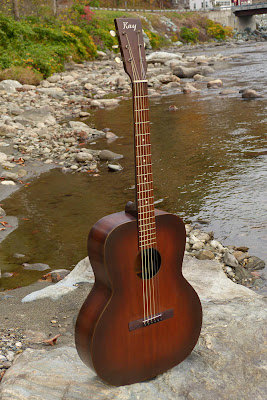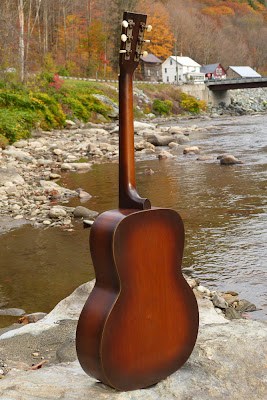c.1940 Kay 000-size Mahogany Guitar
It's funny because I've had an unusual number of people asking after this guitar before its completion. If you're one of them that I haven't gotten in touch with -- let me know. I'm sometimes surprised at what gear is getting popular!
At any rate, this is a 000-size Kay (amazingly, actually branded Kay at the headstock rather than some distributor's mark) built around 1940 and shares the brown-burst-finished mahogany plus painted-on brown "binding" look that both this Kay acoustic and this Oahu lap steel (also made by Kay) both have, too.
It feels a bit different in the lap than your typical 000-size Martin 14-fretter, probably because of the squarer upper bout, though it does have the same 4 1/8" depth and 15" lower bout width. In addition it has a quite long scale (25 7/8") and a lightly-ladder-braced top. These two features mean it has to be strung light to be safe for the long haul: I've got extra-light 48w-10s on it right now for standard-pitch tuning.
Believe me, you have to be careful with ladder-braced guitars and long scales. Even with these light strings, the top deflected over the two "shop closed days" a hair over 1/16" and then settled there. I then re-cut the bridge down and finished my setup work. I typically let ladder-braced guitars sit a few days before final setup after first stringing because of this natural deflection under tension.
That said, the sound on this is full, woody, warm, and rich. It sounds closer to an actual all-hog Martin than I'd expect... it's got that same sort of slightly nasal "cluck" into warmth leading into the low and mid-range notes when you're playing melody or lead lines on it. Sustain is nice, too, but unlike an x-braced guitar the overtone sequence isn't as refined -- it's more "airy" and woody than truly deep. It's really a fun guitar for old-timey fingerpicking and lead work, for sure, though.
The top and sides are solid mahogany while the back is laminated mahogany and the neck is poplar or maple. The fretboard is a lightly-radiused, weirdly-decorated hard maple, the frets are brass. I replaced the original bridge with a new rosewood one with a fret saddle. I also installed a rosewood bridge plate over the original to give that area a bit more strength. Both the bridge pins and endpin are new ebony ones.
Other work included: fret level/dress, fretboard extension recut/reglue, added shim into the overly-deep neck pocket area to ensure that the (already well-set) neck won't drift, some seam reglues, tuner lube, cleaning, and setup. I also added cleats to an already-reglued (but not the best work) center seam below the bridge to keep it happy for the future.
Original bone nut and Kay mark. This has a 1 11/16" nut and modern-y closer string spacing. The neck itself is a mix between a mild V and medium-big C shape. It's plenty fast, though, along the lines of a 30s Gibson in depth.
Plastic dots...
The neck had some light relief that was dialed out with the fret level/dress. The treble side has some very slighy relief overall (around 1/64") but it's essentially irrelevant.
Here's that new rosewood bridge I had to recut a couple times before before the action settled at 3/32" at the 12th fret (nice and comfy-quick) on the bass side and slightly under that on the treble.
Aside from the old repair to the center seam, there are no cracks in the guit and the finish is actually relatively clean. Very few nicks and dings and scratches on the front, but there's a bit of buckle wear on the back.
Here you can see how the old repair to the center seam doesn't 100% match up, but it's good and sturdy, regardless. I added cleats to keep it stable.
These are the same tuner types used on many 30s Gibsons of the lower pecking order.
Heel cap!
...and new ebony endpin.
















Comments